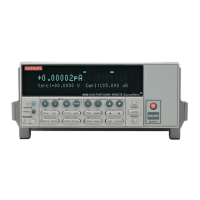

Do you have a question about the Keithley 6430 and is the answer not in the manual?
| Type | Sub-Femtoamp Remote SourceMeter |
|---|---|
| Compliance Voltage | 200 V |
| Maximum Output Voltage | 200 V |
| Maximum Output Current | 100 mA |
| Compliance Limit | Programmable |
| Interface | GPIB, RS-232 |
| Input Impedance | >10^14 Ω |
Details setup for source-measure operations: function, values, limits, and output control.
Discusses compliance limits, values, and determination.
Covers voltage/current boundaries for source, sink, I-source, V-source, and source-measure modes.
Discusses available ranges, limits, manual/autoranging, and display resolution.
Provides information on 3-stage filtering to reduce reading noise.
Details math (FCTN) operations: power, offset ohms, varistor, etc.
Discusses setup, configuration, delay setting, and performing sweeps.
Discusses trigger model, layers, event detection, delay, and device action.
Details how to configure various triggering aspects.
Details remote trigger model, commands, and basic triggering example.
Discusses three limit types: compliance, coarse, fine; summarizes grading and sorting modes.
Describes configuration for limit tests and typical test procedure.
Describes using Digital I/O Port as a safety interlock.
Explains programming Status Byte for SRQs and using serial poll to detect SRQs.
Lists IEEE-488.2 common commands used by the SourceMeter.
Provides detailed reference for common commands, excluding status structure.
Provides detailed info on commands to configure measurement function.
Describes commands to acquire post-processed readings, trigger, acquire, and single measurement.
Details restoring factory defaults, setting ranges, and output values.
Covers procedures to verify mainframe accuracy alone.
Includes procedures to calibrate the mainframe without the Remote PreAmp.
Covers procedure and part numbers for replacing the line fuse.
Discusses safety concerns for measurements up to 42V above chassis ground.
Explains reducing leakage currents using insulators, humidity control, and guarding.